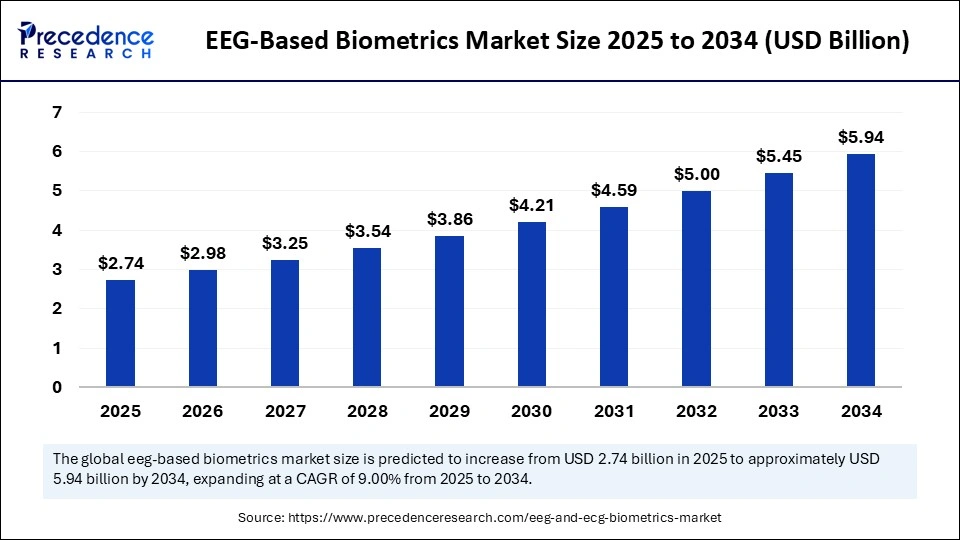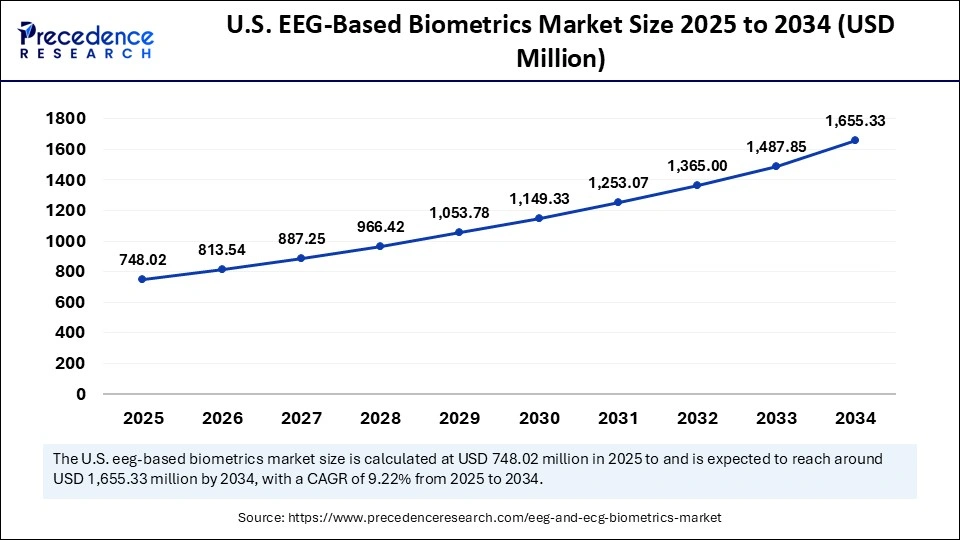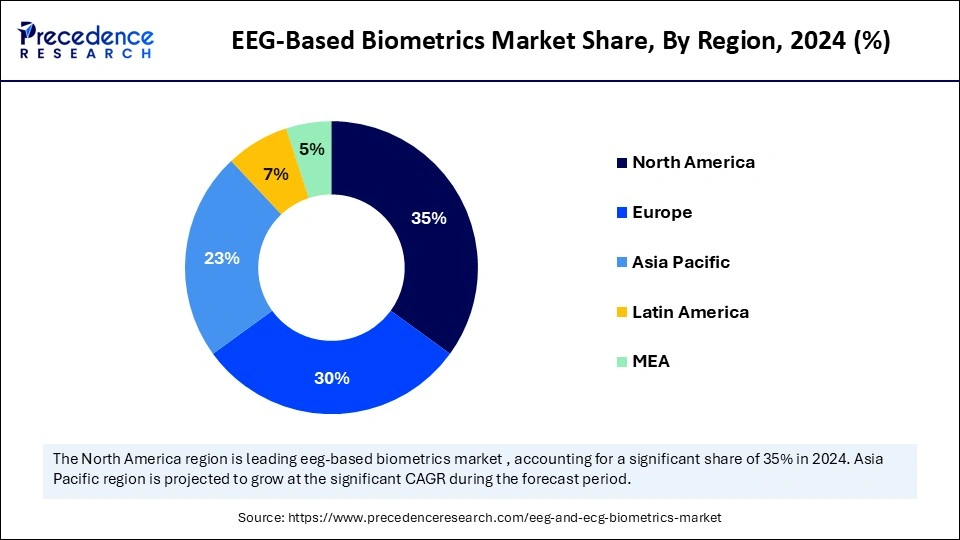List of Contents
What is EEG-Based Biometrics Market Size?
The global EEG-based biometrics market size was calculated at USD 2.74 billion in 2025 and is predicted to increase from USD 2.98 billion in 2026 to approximately USD 5.94 billion by 2034, expanding at a CAGR of 9.00% from 2025 to 2034. The increased demand for secure and efficient biometric solutions is driving the global market. Growing emphasis on health monitoring is further contributing to this growth.

Market Highlights
- North America dominated the global EEG-based biometrics market with a share of approximately 35% in 2024.
- Asia Pacific is expected to grow at a significant CAGR from 2025 to 2034.
- By component, the hardware segment contributed the approximately around 60% of the market share in 2024.
- By component, the software segment is expected to grow at a notable CAGR between 2025 and 2034.
- By signal paradigm, the resting-state EEG segment led the market while holding the largest share of approximately 55% in 2024.
- By signal paradigm, the evoked potentials segment will grow at asignificant CAGR between 2025 and 2034.
- By authentication mode, the one-time authentication segment led the market with approximately 45% share in 2024.
- By authentication mode, the continuous authentication segment will grow at a notable CAGR between 2025 and 2034.
- By end-use industry, the cybersecurity and IT access control segment led the market by holding a share of approximately 40% in 2024.
- By end-use industry, the consumer electronics segment will grow rapidly between 2025 and 2034.
- By deployment mode, the on-premises systems segment held a market share of approximately 60% in 2024.
- By deployment mode, the cloud-based platforms segment will grow at a considerable CAGR between 2025 and 2034.
Market Size and Forecast
- Market Size in 2025: USD 2.74 Billion
- Market Size in 2026: USD 2.98 Billion
- Forecasted Market Size by 2034: USD 5.94 Billion
- CAGR (2025-2034): 9.00%
- Largest Market in 2024: North America
- Fastest Growing Market: Asia Pacific
Market Overview
EEG-based biometrics: identity recognition and authentication methods that use an individual's electroencephalogram (EEG) signals, which measure brain electrical patterns, as unique, repeatable biometric traits processed by hardware, signal-processing algorithms, and matching engines. Electroencephalography is a non-invasive method used to measure electrical activity in the human brain. The technology has evolved into various forms and is now employed for diverse applications, including scientific research, diagnostic tests, and a growing array of consumer applications.
The growing use of wearable devices has boosted innovations and demands in EEG-based biometrics. This growth is driven by increased demand for non-invasive biometric identification systems, advancements in wearable technology, and a growing focus on health monitoring. Researchers are focusing on evolving EEG device use in fields like gaming and cognitive improvement to expand the device's reach.
What are the Key Trends of the EEG-based Biometrics Market?
- Increased Neurological Disorders: The prevalence of neurological disorders has increased, such as alzheimers disease, parkinson's disease, and epilepsy, driving the need for advanced EEG devices for monitoring and diagnosis.
- Increased Awareness about Mental Health Issues: The awareness about brain health, well-being, and early diagnosis has increased of neurological conditions driving the adoption of EEG-based technologies for applications such as neurofeedback.
- Demand for Non-Invasive Health Monitoring: Demand for non-invasive monitoring devices and real-time tracking of brain waveforms has increased, driving adoption of EEG-based biometrics for diagnosing and controlling neurological disorders.
- Growing Geriatric Population: Growing geriatric populations have boosted the need for EEG-based biometrics as they are more susceptible to neurological disorders.
- Advancements in EEG Technologies: The technological advancements in EEG biometrics, including portable and wireless EEG systems to enhance patient comfort and enable ambulatory EEG monitoring, are transforming the market.
Market Scope
| Report Coverage | Details |
| Market Size in 2025 | USD 2.74 Billion |
| Market Size in 2026 | USD 10.55 Billion |
| Market Size by 2034 | USD 5.94 Billion |
| Market Growth Rate from 2025 to 2034 | CAGR of 9.00% |
| Dominating Region | North America |
| Fastest Growing Region | Asia Pacific |
| Base Year | 2025 |
| Forecast Period | 2025 to 2034 |
| Segments Covered | Component, Signal Paradigm,Authentication Mode,End-Use Industry,Deployment Mode, and Region |
| Regions Covered | North America, Europe, Asia-Pacific, Latin America, and Middle East & Africa |
Market Dynamics
Market Drivers
Increased Adoption in Healthcare
The adoption of EEG-based biometrics has increased in healthcare, driven by healthcare expenditure and government investments in medical technologies. The expanding healthcare expenditure is driving the need for enhanced healthcare security against medical fraud and theft identification. The growing emphasis on touchless identification solutions after the COVID-19 pandemic and the growing trend of remote patient monitoring devices and telemedicine approaches are further adding to the growing demand. Developments of wearable EEG devices for remote and continuous health tracking are transforming this growth. Additionally, advancements in technologies for various applications such as patient identification, personalized healthcare, and access control are driving a shift toward EEG-based biometrics.
Restraint
High Implementation Cost
The cost associated with the implementation of EEG-based biometrics is the major restraint for the global market. EEG-based biometrics requires specialized hardware and software, which adds to the initial investments. The requirement of specialized technical expertise for maintenance and interventions of devices also contributes to high-cost investments. Additionally, the cost associated with regulatory compliance and aids hinders the adoption of EEG-based biometrics across small-scale organizations or budget-conscious businesses.
Opportunity
Advancements in AI and Machine Learning
Technological advancements, such as the integration of AI and ML into EEG devices to improve diagnostic capabilities and experiences, are holding transformative opportunities for market growth. Advancements in AI and ML are enabling high accuracy and efficiency of EEG signal analysis, making secure and reliable biometric authentication. AI and ML enhance accuracy and reliability through comprehensive feature extraction, enable real-time portable device applications, and improve system efficiency. AI and ML play a crucial role in the effective process and analysis of complex EEG signals by extracting unique features for biometric identification. The rising demand for secure authentication, advancements in deep learning, and integration of EEG biometrics with wearable devices are contributing to essential advancements in AI and machine learning algorithms.
Segment Analysis
Component Insights
Which Component Segment Leads the EEG-Based Biometrics in 2024?
In 2024, the hardware segment led the EEG-based biometrics market, due to increased demand for reliable and secure identification and authentication solutions. The EEG hardware is highly accurate, reliable, and offers high performance for secure identification, driven by its use in fundamental building blocks for capturing and processing EEG data. EEG headsets, amplifiers & acquisition modules, ancillary sensors, and electrodes & leads are the major hardware uses in biometrics. The ongoing advancements in sensor technologies for more compact, efficient, and affordable offerings are driving the adoption of EEG hardware.
The software segment is the second-largest segment, leading the market due to its use in analysis and interpretation for capturing brain activity data. The software EEG offers highly accurate recognition, flexible integration, and scalability. Software EEG biometrics, such as angle pre-processing, feature extraction & matching engines, SDKs & APIs, and liveness and anti-spoofing modules, are trending in the market. Software components are essential for enhancing adaptability, affordability, and real-time processing of biometric systems.
Signal Paradigm Insights
What Made Resting-State EEG Segment Dominate the EEG-Based Biometrics Market?
The resting-state EEG segment dominated the market in 2024, due to its accuracy in identification and authentication. The resting-state EEG is highly used in EEG biometrics for accuracy and practicality. The resting-state EEG is classified into shorter and longer segments, where the longer resting-state EEG is highly used for open-eyed recording and short viability. The resting-state EEG is the most preferred signal for experimental and practice use applications.
In May 2025, NEUROSECURE ID was published, exploring the use of resting-state EEG and a stance-based classifier with Mahalanobis distance and match-score fusion technology to gain 100% accuracy of classification. This result is intended for the authentication task to improve biometric security.
The evoked potentials segment is expected to grow fastest over the forecast period, driven by its use in increasing accuracy, stability, and potential for online use. The evoked potentials, particularly visual evoked potentials (VEPs), provide high signal-to-noise ratios and stability, helping to achieve 100% accuracy in several tests. The evoked potentials are significant techniques for person identification applications. The use of evoked potentials is high in applications like IoT security due to its ability of performance to perform more practical and trustworthy biometrics.
Authentication Mode Insights
Which Authentication Mode Dominates the EEG-Based Biometrics Market?
The one-time authentication segment dominated the EEG-based biometrics market in 2024, due to increased demand for highly personalized user experiences. The one-time authentication is simple and reduces complexity compared to multi-time authentication or continuous systems. This authentication is less time-consuming and requires less effort to capture, making it suitable for users with personalized demands. The one-time authentication becomes easier and more affordable for deployment in various environments, due to simple hardware and data processing.
The continuous authentication segment is the fastest-growing segment in the market, growth driven by the increased need for improved security and real-time identity verification. Continuous authentication offers ongoing monitoring and brain activity analysis, which helps to make unauthorized access difficult. The continuous authentication hinders unauthorized users from gaining access to sensitive information, making it a more reliable and secure biometric. The growing demand for a unique ability to support constant and context-aware security in dynamic areas drives the need for continuous authentication.
End-Use Industry Insights
Which End-Use Industry Segment Dominates the EEG-Based Biometrics Market?
The cybersecurity and IT access control segment dominated the market in 2024, due to increased demand for cutting-edge and secure authentication for protecting against evolving threats. The rapidly growing threat landscapes have boosted the need for secure and more accurate authentication and identification alternative solutions to traditional biometrics, driving demand for EEG-based biometrics. The EEG integrated with biometric and EFID technologies is ideal for cybersecurity and IT access control applications. The ability of EEG biometrics to resist fraud attempts and coercion makes them suitable for high-security applications such as cybersecurity and IT access control.
The consumer electronics segment is the second-largest segment, leading the market, due to increased demand for more accessible and affordable EEG devices. The growing integration of user-friendly EEG devices and software in daily applications such as neuromarketing, personal authentication, and improving user experiences is contributing to this growth. The technological advancements in AI, cloud computing, and consumer-grade hardware with contactless authentication techniques are contributing to the growing research and expansion of the use of EEG biometrics. The software-driven innovations are trending in the EEG-based biometrics market.
Deployment Mode Insights
Why On-Premises Systems Dominated the EEG-Based Biometrics Market in 2024?
In 2024, the on-premises systems segment dominated the market, due to rising demand for high-security environments in healthcare as well as corporate. The growing concern of data privacy is a major factor driving demand for EEG-based biometrics. With the potential of going beyond conventional methods, the EEG biometrics are gaining popularity for more accurate and secure biometric modalities. On-premises deployments are the premier adopters of these biometrics to secure sensitive data stored locally and avoid cloud-associated risk or threats.
The cloud-based platforms segment is expected to grow fastest over the forecast period, driven by increased adoption of EEG-based biometrics in cloud-based platforms and solutions. The cloud platform offers essential infrastructure for managing and processing a large volume of EEG data. The EEG biometrics provides scalable, large datasets, remote access to analysis, and a reduction of cost against compact local infrastructure. The EEG biometrics are accelerating their practical implementations and potential applications in cloud-based platform deployments.
Regional Insights
U.S. EEG-Based Biometrics Market Size and Growth 2025 to 2034
The U.S. EEG-based biometrics market size was exhibited at USD 748.02 million in 2025 and is projected to be worth around USD 1,655.33 million by 2034, growing at a CAGR of 9.22% from 2025 to 2034.

North America EEG-Based Biometrics Market
North America dominates the global market, driven by regional well-established healthcare infrastructure, growing neurological disorders, and awareness about mental health. The demand for secure authentication has increased in North America, boosting the adoption of EEG biometrics. North America has witnessed rapid growth in the adoption of EEG biometrics for applications like mental health, fitness tracking, and gaming for neural interfaces. Growing emphasis on advancements of next-generation biometrics like innovative brain computer interfaces, increased research & development, and demand for secure & personalized experiences are bringing significant innovations in the emerging market.
U.S. Market Trends
The U.S. is a major player in the regional EEG-based biometrics market, contributing to growth due to countries' strong healthcare infrastructure, focus on technological advancements, and the existence of major technology companies. The demand for EEG biometrics has increased in the healthcare, government, and consumer electric sectors. Robust investments in R&D and technological innovations are fostering this market growth.

Asia Pacific EEG-Based Biometrics Market
Asia Pacific is the fastest-growing region in the global market, contributing to growth due to the region's expanding healthcare infrastructure. The demand for EEG biometrics is increasing in regional healthcare for remote monitoring and personalized services. Rapid advancements in healthcare and wearable technologies are fueling this adoption. Countries like China, Japan, India, and South Korea are playing a market expansion due to increased research and development and adoption of EEG biometrics. The growing geriatric populations and awareness about mental health issues are transforming the market.
Asian Countries and Their Trends in the Regional Market
China, Japan, and India are leading the regional market, driven by countries' strong emphasis on technological advancements, the growing geriatric population, expanding healthcare expenditure, investments in R&D, and increasing prevalence of neurological disorders. China and India are the major players in the regional market due to their large population and robust adoption of national ID programs. Japan is leading the market due to the aging population of the country, strong investments in corporate for biometric innovations, and high demand for convenience and advanced technologies.
Value Chain Analysis
- Testing and Certificatio
The performance testing of EEG-based biometrics evaluates research-defined metrics including F1 score, accuracy, precision, and recall, by using publicly available databases and self-relative bodies. iBeta Quality Assurance lab works precisely for testing a variety of biometric technologies, including EEG-based.
Key Players: Cognionics, Neuroelectrics, Advanced Brain Monitoring (ABM), and Emotiv.
- Installation and Commissioning
Installation of EEG-based biometrics involves hardware setup and software setup. Similarly, in commissioning testing & calibration, enrollment and & baseline recording are involved.
Key Players: NeuroSky, Emotiv, Advanced Brain Monitoring (ABM), and Neurotechnology.
- Maintenance and After-Sales Service
The companies that develop the biometric products are mostly specialized BCI (brain-computer interface) firms. The maintenance and after-sales services are directly handled by those companies.
Key Players for Hardware Aervices: Emotive, NeuroSky, Cadwell Industries Inc., and Natus Medical Incorporated.
Key Players for Software Services: Aware Inc., Neurotechnology, and iMotions.
Key Market Players
- Emotiv
- NeuroSky
- OpenBCI
- InteraXon (Muse)
- g.tec medical engineering GmbH
- ANT Neuro
- Brain Products GmbH
- BioSemi
- Compumedics (Neuroscan)
- Natus Medical Incorporated
- Nihon Kohden Corporation
- Neuroelectrics
- Cognionics, Inc.
- Wearable Sensing
- Advanced Brain Monitoring, Inc.
- mBrainTrain (MBT)
- Neurosoft
- Cadwell Laboratories, Inc.
- Electrical Geodesics, Inc. (EGI)
- BrainVision
Recent Developments
- In July 2025, a paper on Dependable and secure computing proposes a new EEG-based biometric approach by using fuzzy logic and metaheuristic identification optimization was published in the IEEE Transactions. The report explored the use of fuzzy logic and metaheuristic-optimized EEG biometric systems to increase accuracy to about 99% in the unique identification of individuals according to their brainwave patterns.
- In April 2025, the discussion overview about the latest advancements in EEG-based biometric identification, multimodal datasets, and emotion recognition was published by the authors of “EEG-based biometric identification and emotion recognition: An overview,” on ResearchGate. The paper demonstrated how emotional state can influence EEG signals and the role of exploration of multimodal datasets to enhance accuracy. (Source: https://www.researchgate.net)
Segment Covered in the Report
By Component
- Hardware
- EEG headsets (wired, wireless, wearable)
- Electrodes & leads (wet, dry, semi-dry, textile)
- Amplifiers & acquisition modules
- Ancillary sensors (IMU, motion sensors)
- Software
- Signal pre-processing
- Feature extraction and matching engines
- Liveness and anti-spoofing modules
- SDKs and APIs
- Services
- System integration
- Maintenance and calibration
- Consulting and compliance support
By Signal Paradigm
- Resting-state EEG
- Evoked potential
- Cognitive-task signatures
- Hybrid paradigms
By Authentication Mode
- One-time authentication
- Continuous authentication
- Multi-factor authentication
- Forensic verification
By End-Use Industry
- Cybersecurity and IT access control
- Banking and financial services
- Government and defense
- Healthcare and clinical access
- Consumer electronics
- Automotive security systems
- Enterprise workforce security
- Education and exam proctoring
- Gaming and entertainment
- Research and academic applications
By Deployment Mode
- On-premises systems
- Cloud-based platforms
- Hybrid deployment
By Region
- North America
- Europe
- Asia Pacific
- Latin America
- Middle East & Africa
For inquiries regarding discounts, bulk purchases, or customization requests, please contact us at sales@precedenceresearch.com
Frequently Asked Questions
Ask For Sample
No cookie-cutter, only authentic analysis – take the 1st step to become a Precedence Research client